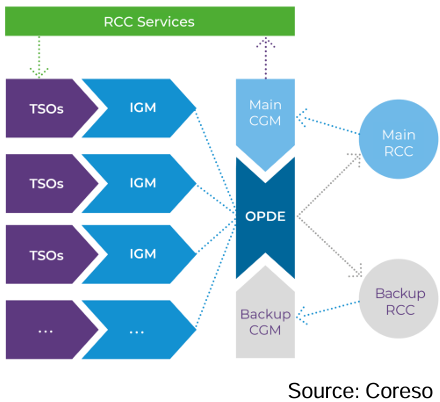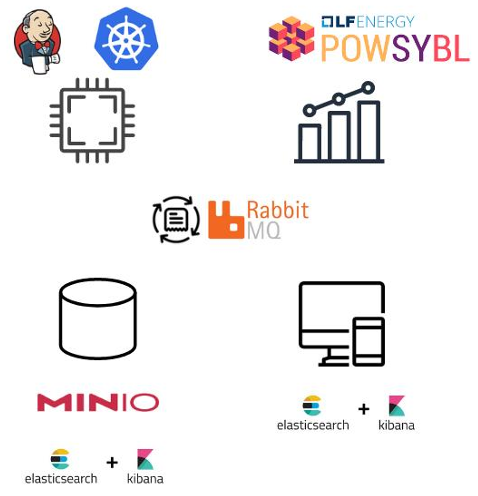Baltic RCC’s Use of Open Source Technology to Meet Energy Transition Challenges
View this case study in PDF format
Overview
Baltic RCC, a Regional Coordination Center (RCC) responsible for ensuring electricity network security and operational efficiency across the Baltic region, faced significant challenges in managing the complexities of Europe’s evolving grid. With the rise of renewable energy sources and the increasing need for cross-border cooperation, Baltic RCC sought to improve grid stability, streamline network model management, and ensure compliance with EU regulations (EU 2019/943).
Instead of relying on proprietary solutions that could create vendor lock-in and long-term dependencies, Baltic RCC chose to build an open source, community-driven solution. Key to this approach was leveraging components from the LF Energy PowSyBl project, an open source initiative designed to facilitate grid modeling, simulations, and analysis.
Challenge
As Europe’s electricity grid evolved toward a more interconnected, decentralized model, several critical challenges emerged for Baltic RCC:
- Complex Network Modeling: With each Transmission System Operator (TSO) in Europe having developed independent network models, merging these into a unified Pan-European model was a complex and resource-intensive process. Ensuring grid security and conducting “what-if” scenarios required comprehensive and accurate network models.
- Compliance with EU Regulations: Under the EU 2019/943 regulation, RCCs are required to provide a Pan-European network model for assessing grid stability and ensuring the system can handle potential outages without cascading failures.
- Avoiding Vendor Lock-In: Traditional software providers in the energy industry often offer proprietary solutions with high licensing costs and long-term dependencies. Baltic RCC wanted to avoid these risks and maintain control over the development and evolution of its tools.
- Lack of Expertise in Some Domains: Baltic RCC initially lacked internal DevOps expertise needed to build and maintain such a complex system in-house, posing a challenge for the development of their custom solution.
 Solution
Solution
To overcome these challenges, Baltic RCC opted for an open source approach, partnering with LF Energy and utilizing components of the PowSyBl (Power System Blocks) project, particularly PyPowSyBl for network modeling and load flow calculations.
The key aspects of the solution included:
- Use of PyPowSyBl for CGMES File Import and Load Flow Calculations: Baltic RCC incorporated the PyPowSyBl library to manage Common Grid Model Exchange Standard (CGMES) files, a format critical for exchanging and merging network models across TSOs. PyPowSyBl also facilitated performing load flow calculations, a core function needed for assessing grid stability and maximum allowed energy flows.
- Modular Architecture with Open Source Tools: Baltic RCC divided the European Merging Function (EMF) into several logical functional components:
- Data Exchange: Managed through OPDE (Operational Planning Data Environment) and RabbitMQ for reliable message brokering.
- Data Storage: Implemented using Minio, an open source S3-compatible object storage platform.
- Visualization: Built using Kibana, an open source platform for monitoring and visualizing the entire process.
- Collaboration with RTE International: Baltic RCC partnered with RTE International, leveraging their expertise and open source tools from PowSyBl, which have been extensively used in grid load flow analysis for years. This collaboration allowed Baltic RCC to access proven, well-maintained tools without being locked into proprietary ecosystems.
- Community-Driven Development: Instead of outsourcing the entire solution to a third-party vendor, Baltic RCC took on the role of both developer and provider. By creating an open source community around the project, they were able to attract additional expertise and support from other RCCs and interested stakeholders.
 Results
Results
Baltic RCC successfully developed an open source solution for managing and merging network models, overcoming the challenges of complexity, compliance, and vendor lock-in. Key outcomes included:
- Operational Pan-European Network Model: Using PyPowSyBl’s capabilities, Baltic RCC was able to create a working Pan-European network model that complies with EU regulations and supports grid stability analysis. The solution allows for detailed “what-if” analyses and ensures that any single outage does not cause cascading failures across the grid.
- Avoidance of Vendor Lock-In: By choosing open source components, Baltic RCC avoided the risks of becoming dependent on a single vendor’s tools or licensing models. They retained full control over the development and customization of their solution.
- Foundation for Future Development: By choosing open source components, Baltic RCC avoided the risks of becoming dependent on a single vendor’s tools or licensing models. The open source nature of the project means new features and improvements can be developed in collaboration with the wider community.
- Community Engagement and Growth: While building the open source community has been challenging, especially given industry prejudices regarding security and compliance, Baltic RCC continues to engage with other RCCs and solution providers. The more advanced and stable the solution becomes, the more interest and contributions are expected from the broader energy sector.
 Conclusion
Conclusion
Baltic RCC’s open source approach, including leveraging LF Energy’s PowSyBl components such as PyPowSyBl for CGMES file management and load flow calculations, has proven to be an effective strategy for addressing the complex challenges of the energy transition. By avoiding vendor lock-in and fostering community collaboration, Baltic RCC has developed a scalable and compliant solution that provides long-term value for the Pan-European energy grid.
References:
